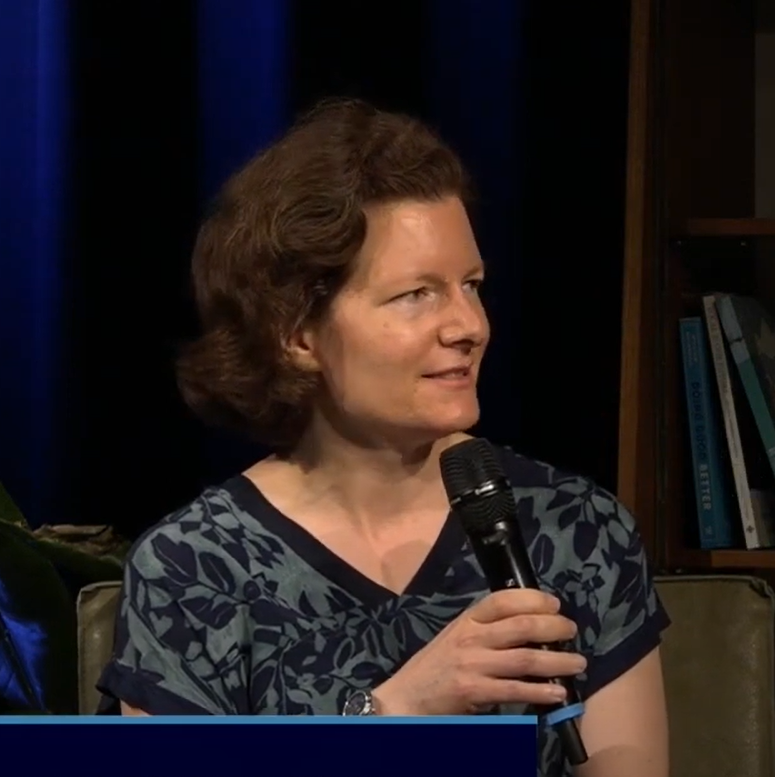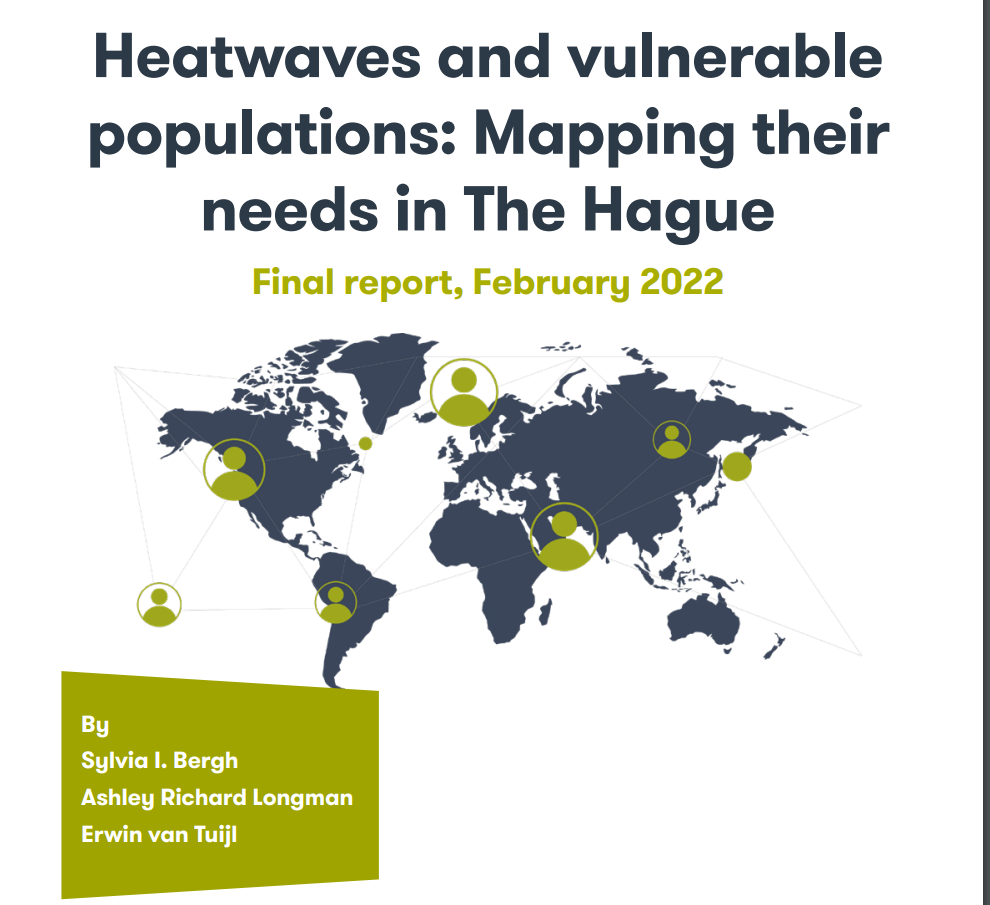The effects of heatwaves in the EU
Dr Sylvia Bergh and Shellan Saling discuss their research into the effects of heatwaves on vulnerable populations and the EU’s (missing) policy response.
The effects of heatwaves in the EU
Sylvia (Sy): With some colleagues from The Hague University of Applied Sciences and the ISS, I got a small grant from the municipality of The Hague in early 2021. We decided to work on the effects of heatwaves on vulnerable population groups in The Hague, something the municipality was also working on. It was an applied research project, which I knew would also be interesting for ISS students. We did research in The Hague, but I realized that elderly people and people from migrant or socio-economically weaker backgrounds have things in common with people in developing countries in the sense that they can't easily protect themselves from the heat. Simply because if you can't afford sunscreens or air conditioning, you are at a real disadvantage.
This project taught me a lot about the health effects of heat. I learned that the danger lies not only in heat strokes, but also that heat can aggravate underlying health conditions such as chronic diseases. I found that most interesting.
In terms of the policy response, I wanted to investigate what the municipality can do. The research got me thinking about the region that I know most about, the Middle East and North Africa, and I started thinking about the response to heat there.
And then you came along as a as an MA student and we decided to work together.
Shellan (Sh): Indeed. At the time, I had no idea what I wanted to do for my Research Paper. My background is in disability rights and gender, but I felt that there was a bigger picture and that I could maybe combine gender and disability. I thought your project sounded really interesting. I had never considered that heatwaves were even something worth studying from a social science perspective.
Sy: For your Research Paper, we decided to focus on the European Union; on two countries in particular, the Netherlands and France, but also on the EU response. That provided a great opportunity to approach this topic from a multi-level governance perspective, from the local municipal level up to the country and EU level. You did that part so maybe you can tell us about your findings from the Netherlands and France and how the National Heat Health Action Plans differed.
Sh: Yeah, it was interesting. Honestly, I never thought I would find myself talking about heatwaves, especially in the European Union. On reflection, I was a little bit in over my head because at that time I had no knowledge or background on the governance system or structure of the EU. So it was a huge learning curve for me. My focus was on comparing the French national heat plan to the Dutch one and comparing these to the wider EU policy response.
I think we were both surprised at the results. The EU is supposed to be a leader in climate change and climate resilience and heatwaves are the leading cause of climate-change related deaths in the EU. From what I found, the response is very limited and there's not even a common EU definition for heatwaves. If you compare France's heatwave plan to the Netherlands’ plan, you find that they have very different definitions of what a heatwave is. So even that simple starting point is so different.
Sy: We were also surprised that the Netherlands had quite a weak plan; little more than a communication plan. One of our interviews was with the Heat Plan Coordinator of the Netherlands who said it was really easy for people to miss the communication and simply not get the information they needed. What I found interesting in your research was that in France somebody is designated to deal with this and if they fail in their task of providing information, other governance levels take over. Precautions and measures have to be put in place and there's even a list of vulnerable people who need particular care. That's a big contrast with the Netherlands.
Sh: The response was quite different. For example, in the Netherlands you'll see news reports during a heatwave with everybody at the beach whereas in France everyone's instructed to stay at home. I think that part of France's stricter policy response, its more stick than carrot approach, has to do with the trauma of the 2003 heatwaves which I believe killed over 70,000 people in Europe with France experiencing the highest number of deaths. One of our French interviewees confirmed that there was still trauma among government officials. That trauma really sparked the creation of France's Heat Action Plan and explains why people in France are cautious. The trauma has led to the creation of a lot of laws; there are a lot of sticks in France’s plan. For example, news channels have to broadcast heat warnings from the Ministry of Health. There are simply no sticks in the Netherlands' national Heat Plan. And it's also very decentralized, in contrast to France's plan which is very centralized.
Sy: I think the Netherlands just started at the local level. The government realizes that, in order to be effective, national plans have to be translated into concrete measures at the local level. Last year (2021) was the first time that The Hague had had such a plan. It was a bit unfortunate that in the year that we got the research grant there was no heatwave!
Sh: What do you think were the most shocking results?
Sy: We looked critically at The Hague’s local heat plan and asked ourselves how it could be improved. For example, a cooling centre is a good idea but would people actually go there? We interviewed the elderly and people living in social housing who told us that they would prefer to have a common room so that their building has at least one room with air conditioning.
The most surprising finding was the fact that these are people that we tend to forget; it's elderly people living alone at home who are the most vulnerable. This is a trend which will continue in Europe because we are getting older and lonelier. If you cross-reference the loneliness maps and heat maps, which every municipality nowadays must have, you can see the overlap: the loneliest people also live in the hottest places and so are the most vulnerable. That alone was quite an eye opener.
The other main finding was that these people don't realize that they're vulnerable. How can you help somebody who doesn't realize that they're vulnerable? Even when you communicate the risks to them, they may think, 'well, they're not talking about me. Maybe about my neighbour but I'll be fine'. That's a real public health communication challenge. We had some interesting examples from the Red Cross and other organizations of how they do that.
A new term we both learned from our interview with someone at the European Environmental Agency is the 'risk signature' of heat; a term I'd never heard before. In Europe, we tend to associate warm weather with something nice and pleasant, with holidays, when in fact, it's a silent killer. In France, especially in the south of France and in other Mediterranean countries, houses have shutters that keep the rooms dark and cool all day long. But northern European homes, with their large windows, are not really built for climate change.
Sh: Not at all! The Netherlands doesn't regularly update its Heat Health Action Plan. There are incentives from the government to make homes greener but these aren't actually mentioned in the Plans. In my research, I had to dig quite deep to understand many of the recommendations in the Heat Health Action Plan. For example, the Netherlands Enterprise Agency (RVO) has a list of available subsidies to make your home greener or more climate proof, but the Heat Health Action Plans don't mention them; it gives the recommendations but doesn't mention the government's incentives. This means that there's no incentive for people to protect themselves, whether it's on a daily basis or to protect their homes on a long-term basis.
Sy: We also found research that showed that subsidies in The Hague for green roofs, for example, go to the richer areas because the people living there know how to get subsidies. Of course, it's not only roofs: we also need sunscreens to be subsidized. And for older people the question is also whether they will invest a few thousand euros in their homes at all for one or more sunscreens?
The other thing that I really enjoyed about our project was looking at frugal innovations: looking at what people come up with themselves. Our colleague at ISS and the International Centre for Frugal Innovation, Erwin van Tuijl did a really great job there. We were also able to share our findings, for example in blog posts.
Sh: Yes, I think the first post you published was right before the first heatwave and the post we wrote together was right after the second heatwave in the Netherlands.
We also presented our research at a conference organized by the Netherlands Institute of Governance in Utrecht which was very well received. I was the only masters student on the panel; the rest were all tenured professors but from the feedback it was clear that there was still a lack of knowledge. Their response was, 'This is a great idea but I don't really know a lot about it'. I found this quite shocking considering that the leading cause of climate change deaths in the Netherlands is heatwaves. So I wonder, why is there a lack of social science research, not just at the Dutch level, but at the EU level? A large part of my research was at the EU level and we found some pretty shocking stuff.
Sy: I think it has to do with the fragmentation of the policy domains. You have climate change mitigation and adaptation, and even the Green Deal doesn't say much at all about heatwaves. And then you have health which is a national sovereignty issue.
Sh: Yes, one thing that's not discussed enough is that climate change falls under several different policy arenas; it falls under health, where there's a lack of discussion; it falls under climate adaptation; it falls under climate resilience; and it even falls under economic policy. But the EU mandates prevent the EU from doing more on heatwaves, and I think climate change in general, because health falls under the national sovereignty of the EU states. Early on in the research we were very puzzled about why the Heat Health Action Plans were not EU mandates.
Sy: You found a guideline from the WHO which the EU had commissioned in 2008 explaining what a good action plan should look like. But it's not at all enforced or monitored.
Sh: Because it falls under health. The EU said of these first guidelines that these Heat Health Action Plans fall under the policy arena of health. And that's what the EU currently looks at as guidelines. And I think that also explains the vagueness of the EU's Green Deal, because it focuses on an economic perspective and doesn't focus on a social perspective.
One thing that was particularly shocking is that one of the first policymakers to come up with the Heat Health Action Plans in France asked me whether I had contacts for the people who created the Heat Health Action Plans in the Netherlands or Germany. That just shows that there's not only fragmentation, there's also a lack of a network among EU member states when it comes to Heat Health Action Plans, or even simply how to respond to heatwaves.
Sy: Indeed. The role of the impact of the research is also important. Our report has been included on Climate-ADAPT which is the portal of the European Environment Agency. And we're also taking advantage of the EUR Impact Journey. Erwin van Tuijl and I applied to be part of a new trajectory involving the private sector and getting innovations onto the market. The suppliers of things like window foil, misting systems or even things that you can put on your balcony to create shade don't know how to access the market, how to access care homes, for example, and get on their procurement list. So really practical things. I think we both agree that research doesn't stop with the publication of a report.
Sh: I think we've raised a lot more questions since our research. Another discussion we've had is the lack of involvement in the private sector, asking why the private sector hasn't been involved. That's still a huge research question that needs to be answered.
Sy: We can now really see climate change happening whereas it used to be distant. I remember not being convinced by the stories but now, especially after this very hot summer in Europe, nobody questions it anymore. So we are now catching up and we need to react. But how? I'm excited that we were able to work together on this research but there's so much more to be done.
Sh: I'm from Marin County in Northern California. Wildfires take place there every single year which scientists think is likely due to climate change. Looking back, we think the first major fire happened because of climate change. I remember thinking when the first major fire happened, ‘Oh, wow. This is the first natural disaster I’ve lived through’. It has become a normal now, but not something you necessarily get used to.
Sy: But is it natural?
Sh: Right! I feel like this is a great opportunity to contribute to research. There's so much physical science research into climate change, but not much social science research. I think this is an exciting time, even though climate change is very scary. We must try to be optimistic and just keep trudging along with how we can make an impact.
Sy: I think that those are great closing words. Thank you.
The effects of heatwaves in the EU


Recent graduate of Master of Arts in Development Studies at ISS



